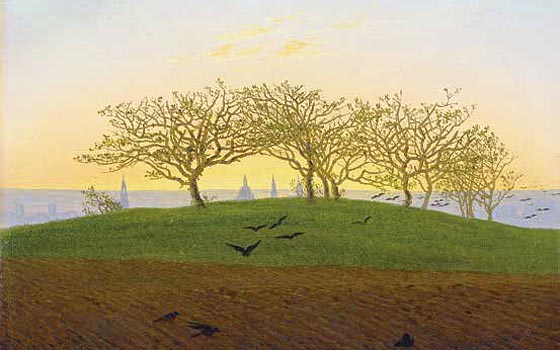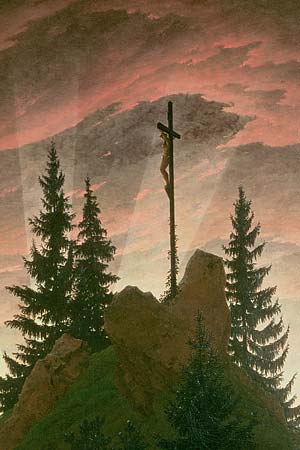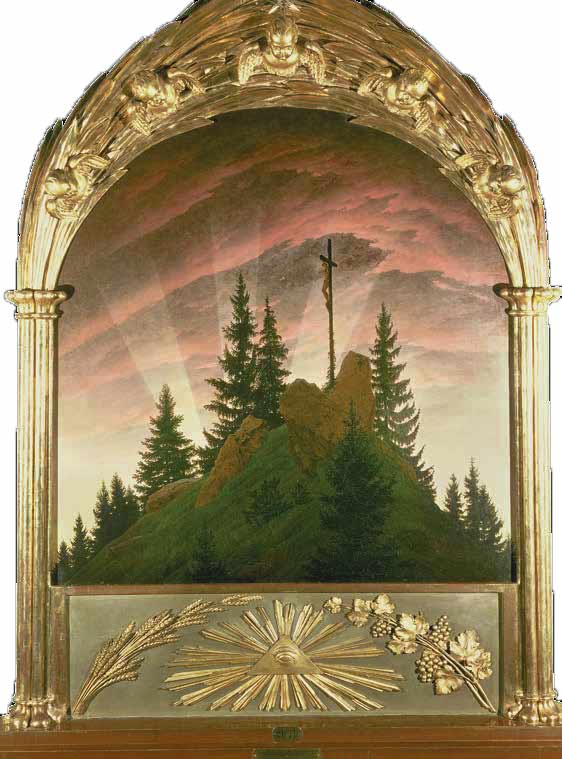Subtotal: $
Checkout-

Digging Deeper: Issue 4
-

The White Lily
-

Hitler’s Nemesis
-

Growing into Manhood
-

Why We Need Stories Like Homage to a Broken Man
-

Editors’ Picks Issue 4
-

Meeting Mary
-

Johnny Appleseed
-

Readers Respond: Spring 2015
-

Report from Rome
-

Together On Marriage
-

A Spark Bird Lights a Fuse
-

Can Anything Good Come from Climate Change?
-

Jesus Is Coming – Plant a Tree!
-

Our Garden, God’s Garden
-

Becoming a Rooted Church
-

A Gospel of the Ground
-

Sacred Seeds
-

Firewood
-

Insights on Creation
-

Conservation Is for Conservatives
-

Where Rivers Meet the Sea
-

The Psalmic Soundtrack of John Muir
-

John Muir’s Gloria in Excelsis

Nature and Revelation
Caspar David Friedrich’s Cross in the Mountains
By Elizabeth Lev
March 31, 2015
Next Article:
Explore Other Articles:
The God who made the world and everything in it, he who is Lord of heaven and earth, does not live in shrines made by hands” (Acts 17:24).
In the history of art, creating a locus for the Lord has remained a ceaseless challenge. Byzantine mosaicists placed him against a golden background outside of space and time; Renaissance painters contained him in perfect perspectival order. In Caspar David Friedrich’s 1807 altarpiece, Cross in the Mountains, for the first time God was revealed in untamed landscape.
Landscape paintings were well known and avidly collected by the nineteenth century, but considered a lesser art form, without the prestige of paintings of historical subjects. The European artistic tradition dictated that any kind of natural setting for the sacred must be clearly dominated by man – hence the dense swards of Leonardo da Vinci and the idealized vistas of Claude Lorrain. Friedrich, unveiling this work in his Dresden studio, sparked a controversy that would force contemporaries to rethink not only art criticism, but also the evocation of the divine.
Friedrich intended Cross in the Mountains as a gift to Gustav IV Adolf, king of Sweden, an erratic but devout monarch. With the king, the artist shared an affinity for the Moravian Brethren, for whom faith was, as their founder Count Zinzendorf wrote, “not in thoughts nor in the head, but…a light illuminated in the heart.”0
The painting reflects both love of a rugged homeland and a deeply personal faith.
, one of the “summit crosses” that have been erected on mountain peaks in the Alps since the thirteenth century, especially in Catholic regions. The cross is placed off-center, a slender naked reed among the densely clad fir trees that flank the mountaintop. The body on the cross turns away from the viewer – something impossible in medieval art and rare in Renaissance works, but not an unknown convention during the Baroque era. The viewer gazes from behind and slightly to the right, as if standing by the lone tree low on the rocky slope.
From the shadows, the viewer lifts his eyes to Christ who reflects light with a polished gleam. The image not only draws one to the light of Christ, but instills a longing to be in the line of his gaze and within the sweep of his outstretched arms.
What lies on the other side of the slope, one wonders? Friedrich has left but a few clues. The trees seem more than just a random scattering; with their tall erect trunks they appear to climb towards the cross with their upturned branches lifted in praise. It is as if the forest itself recognizes in the spent body on the cross’s denuded wood the Master of heaven and earth. The delicate tendril of evergreen ivy climbing up the foot of the cross recalls that human frailty was conquered by Christ, who defeated death itself.
The viewer knows that below the harsh and rocky mountaintop come pastures and villages, and further down, cities which group into nations. When Friedrich painted this work in 1807, war was raging throughout Europe. The Enlightenment, which had promised rationality and liberty for humankind, had dissolved into conflict. Friedrich sought refuge from the violence of his age not in painting the exploits of great men, but in the quiet of nature – terrible and awesome, but without malice.

Caspar David Friedrich, Hill and Ploughed Field near Dresden
Already a subscriber? Sign in
Try 3 months of unlimited access. Start your FREE TRIAL today. Cancel anytime.
The one element of artifice in this work is . The bright wings of the scene gather into thick tumultuous clouds that range from grey-violet to startling pink, stretching from the viewer’s space to the other side of the slopes. Three shafts of light launch into the clouds, but cannot penetrate the dense cumulus. Friedrich described them as the setting sun, perhaps symbolizing the loss of the time when God walked among human beings, or perhaps the dimming of the Enlightenment or even the end of a pagan past.
One ray, however, strikes the body of Christ. Jesus mediates between this dark and light, a meeting between our search for clarity and the mystery of our final destiny. He is the invisible made visible. Serene skies hint at a hope for peace, while the mountain, which at first appears as an obstacle, slowly becomes the anchor of the work, the embodiment of steadfast faith.
The frame, designed by Friedrich himself, gives a more formal setting to the rugged scene. The classical arch crowning Christ is formed by palm fronds, age-old symbols of victory, while the heads of cherubim and seraphim look down at the scene. The predella is designed with a sheaf of wheat and a vine encircling the all-seeing eye of God. Jesus on the cross gazes away from us, but the eye of God, framed by symbols of the Eucharist, stares directly at the viewer.
Confined in its heavily symbolic cornice, the painting takes on a more recognizable religious meaning fitting for a sacred space. But viewed alone, the works offers an iconography that can speak to all Christians: shadow becomes light, and nature both hinders and guides us with its grandeur. In this way, Friedrich’s work recalls the poetry of Saint Francis, whose “Canticle of the Creatures” praises God as he is reflected in his creation:
Praised be you, my Lord,
with all your creatures,
especially Sir Brother Sun.…
He bears a likeness of You, Most High One.
Elizabeth Lev teaches Christian art and architecture at Duquesne University’s Rome campus.
Already a subscriber? Sign in
Try 3 months of unlimited access. Start your FREE TRIAL today. Cancel anytime.
Caspar David Friedrich on his painting:
“Jesus Christ, nailed to the tree, is turned here towards the setting sun, the image of the eternal life-giving father. With Jesus’ teaching, an old world dies – that time when God and Father moved directly on earth. This sun sank and the earth was not able to grasp the departing lightany longer. There shines forth in the gold of the evening light the purest, noblest metal of the Savior’s figure on the cross, which thus reflects on earth in a softened glow. The cross stands erected on a rock, unshakably firm like our faith in Jesus Christ. The firs stand around the cross, evergreen enduring through all ages, like the hopes of man in Him, the crucified.”
A Social History of Modern Art, 2 (University of Chicago Press, 1991)
Already a subscriber? Sign in
Try 3 months of unlimited access. Start your FREE TRIAL today. Cancel anytime.
Footnotes
Joseph Leo Koerner, Caspar David Friedrich and the Subject of Landscape (Reaktion Books, 2009), 60.
Already a subscriber? Sign in
Try 3 months of unlimited access. Start your FREE TRIAL today. Cancel anytime.




































